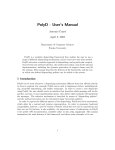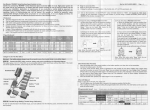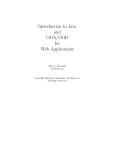Download Chapter 1 SCJ Annotations User Manual
Transcript
Chapter 1
SCJ Annotations User Manual
Last edited by Ales Plsek, Date: 2011/07/25 15:19:15 .
This document provides a simplified description of the metadata annotation system
defined for Safety Critical Java. Further, the document describes the use of the
Checker to verify annotated SCJ applications.
The key concepts of the annotation system and the checker are:
1. Annotation Restating. A user class/method that extends/overrides infrastructure or user code must restate any annotation present on the original class/method.
2. Checker Validation Process. A checker is provided to verify correctness
of annotated SCJ applications. Command line arguments can be passed to
checker to modify the verification process:
(a) -Alevel=0/1/2 — set the SCJ Level of the user application,
(b) -AnoScopeChecks — disables checking of memory safety annotations.
This document is structured as follows:
1. Section 1.1 — The Checker.
(a) Section 1.1.1 — Download and Installation Instructions.
(b) Section 1.2 — Verifying the Installation.
(c) Section 1.1.3 — Running the Checker.
2. Section 1.2 — Annotations Overview.
(a) Section 1.2.1 — @SCJAllowed annotation.
(b) Section 1.2.2 — @SCJRestricted annotation.
(c) Section 1.2.4 — Memory Safety annotations.
3. Section 1.3 — Annotating SCJ Applications — An Introduction.
(a) Section 1.3.1 — Annotating SCJ-given classes.
(b) Section 1.3.2 — More on the use of @Scope.
(c) Section 1.3.3 — Dealing with method invocation.
1
(d) Section 1.3.4 — Using enterPrivateMemory() and executeInArea().
(e) Section 1.3.5 — Default Annotations.
(f) Section 1.3.6 — Dynamic Guards.
4. Section 1.4 — More Resources.
1.1
1.1.1
Checker
Download and Installation Instructions
Follow the instructions below to download and install the Checker.
1. Download the Checker.
The Checker distribution can be downloaded from the http://www.ovmj.
net/oscj/checker/checker.html. Execute:
$ wget http://scj−jsr302.googlecode.com/files/scjChecker.tar.gz
$ tar −zxvf scjChecker.tar.gz
$ export CHECK_HOME=‘pwd‘/checker/
You can also check-out the latest sources from:
$ hg clone https://scj−jsr302.googlecode.com/hg/ scj
$ export CHECK_HOME=‘pwd‘/scj/oSCJ/tools/checker/
The content of the installation directory is listed in Fig 1.1.
2. Installation Instructions
Compiling the SCJ checker currently relies on some bash scripts, which means
you probably need Cygwin to compile on Windows.
(a) Enter the Checker directory:
$ cd $CHECK_HOME
(all the paths in the remaining steps are relative to this directory)
(b) Compile the Checker by running:
$ ant
1.1.2
Verifying the Checker Installation
The checker is distributed with a complex test-suite that verifies the correctness of
the installation process and of the checker on a number of test cases. To run the SCJ
checker tests, simply run ant tests. There are a few other test targets, but they do not
usually need to be run.
1. To run the tests:
2
Version
Confidentiality: Distribution
Dir/File name
doc/
examples/
lib/
localbin/
reports/
spec/
src/
testsuite/
build.xml
check.sh
README
Description
Documentation.
Examples.
Checker jar files.
Contains the Checker Framework JSR-302 distribution.
Testsuite Report (generated by the ant tests).
Annotated Java standard lib (contains e.g. java.lang,java.util).
Checker sources.
TestSuite implementation and Checker test-cases.
Ant build file.
Script for running the Checker.
Readme file.
Figure 1.1: Content of the Distribution Directory.
$ ant tests
2. Then run the following to see the results of the tests:
$ open reports/html/index.html
This command will open a report of the test-cases, an expected report message
should look similarly to the report displayed by Fig. 1.2.
1.1.3
Running the Checker
To check your own program with the SCJ checker, you may use the included check.sh
script:
$ ./check.sh <program files to check...>
or do one of the following:
1. On UNIX:
$ $CHECK_HOME/localbin/javac −proc:only −cp $CHECK_HOME/lib/scj.jar: \
$CHECK_HOME/lib/scj−checker.jar −processor checkers.SCJChecker \
<∗.java program files to check...>
2. On Windows:
$ $CHECK_HOME/localbin\javac.bat −proc:only −cp $CHECK_HOME/lib\scj.jar;\
$CHECK_HOME/lib\scj−checker.jar −processor checkers.SCJChecker \
<∗.java program files to check...>
A typical output of the Checker is shown in Fig 1.3.
Version
Confidentiality: Distribution
3
Figure 1.2: Checker Test-Cases report example.
Figure 1.3: A Checker output example.
1.2
1.2.1
Annotation System Overview
@SCJAllowed Annotation
Description: Annotation restricts the visibility of the SCJ-infrastructure code and
defines the level on which an SCJ application is executed.
Annotation: @SCJAllowed(value=LEVEL_0,LEVEL_1/LEVEL_2,members=true/false)
Command-line options: Use a command-line argument -Alevel to define default
SCJ level of user level classes: Example:
./check.sh −Alevel=0 ∗.java
4
Version
Confidentiality: Distribution
SUPPORT methods: Every method that overrides a @SCJAllowed(SUPPORT)
method code must restate this annotation.
1.2.2
@SCJRestricted Annotation
Description: The annotation restricts the behavior of a body of a method.
Annotation Arguments:
• phase: INITIALIZATION, EXECUTION, CLEANUP, ANY(default)
• mayAllocate: true (default), false
• maySelfSuspend: true (default), false
Usage: The following restrictions may by applied to a method, further, these restrictions should apply transitively also to all the methods invoked by that particular
method.
• define a phase when a method can be executed,
• forbid allocation of a given method,
• forbid the method to be able to self-suspend.
1.2.3
@SCJAllowed and @SCJRestricted Annotations Example
The example presented in Fig. 1.4 and in Fig. 1.5 shows a simple LEVEL_1 application with one periodic event handler annotated with the @SCJAllowed and @SCJRestricted annotations. The reader should notice mainly the following :
1. @SCJAllowed(SUPPORT) is restated for all the infrastructure overriden methods,
2. @SCJRestricted(INITIALIZATION/CLEANUP) are similarly restated.
3. Other @SCJAllowed annotations are omitted assuming that the -Alevel=0/1/2
command line argument was passed to the Checker.
1.2.4
Memory Safety Annotations
The three SCJ annotations for memory safety are summarized in Table 1.1.
The important restrictions of the Annotation System are:
1. A class implementing Schedulable can be instantiated only once per a mission.
2. Static fields are @Scope(IMMORTAL) and can be passed only where an IMMORTAL type is expected.
3. Schedulable-s can be instantiated only in the Mission.initialize() method.
Version
Confidentiality: Distribution
5
public class Level1Hello implements Safelet {
@SCJRestricted(INITIALIZATION)
@SCJAllowed(SUPPORT)
public MissionSequencer getSequencer() {
return new OneSequencer(new PriorityParameters(PriorityScheduler
.instance().getNormPriority()), new StorageParameters(100000L,
1000, 1000));
}
@SCJAllowed(SUPPORT)
@SCJRestricted(INITIALIZATION)
public void setUp() {}
@SCJRestricted(CLEANUP)
@SCJAllowed(SUPPORT)
public void tearDown() {}
static public class OneSequencer extends MissionSequencer {
@SCJRestricted(INITIALIZATION)
OneSequencer(PriorityParameters p, StorageParameters s) {
super(p, s);
}
}
@Override
@SCJAllowed(SUPPORT)
protected Mission getNextMission() {
return new OneMission();
}
static public class OneMission extends Mission {
@Override
@SCJRestricted(INITIALIZATION)
@SCJAllowed(SUPPORT)
public void initialize() {
PEH peh = new PEH(...).register();
}
}
}
@Override
public long missionMemorySize() {
return 1000L;
}
Figure 1.4: @SCJAllowed and @SCJRestricted annotations example — Safelet.
6
Version
Confidentiality: Distribution
public class PEH extends PeriodicEventHandler {
@SCJRestricted(INITIALIZATION)
PEH(PriorityParameters p, PeriodicParameters r, StorageParameters s) {
super(...);
}
@Override
@SCJAllowed(SUPPORT)
public void handleAsyncEvent() {}
}
@Override
@SCJRestricted(CLEANUP)
@SCJAllowed(SUPPORT)
public void cleanUp() {}
}
Figure 1.5: @SCJAllowed and @SCJRestricted annotations example — Handler.
Annotation
@DefineScope
Where
Any
Class
Arguments
Name
Name
CALLER
Name
Field
UNKNOWN
THIS
Name
@Scope
Method
UNKNOWN
CALLER
THIS
Name
Variable
UNKNOWN
CALLER
THIS
Name
@RunsIn
Method
CALLER
THIS
Description
Define a new scope.
Instances are in named scope.
Can be instantiated anywhere.
Object allocated in named scope.
Allocated in unknown scope.
Allocated enclosing class’ scope.
Returns object in named scoped.
Returns object in unknown scope.
Returns object in caller’s scope.
Returns object in receiver’s scope.
Object allocated in named scope.
Object in an unknown scope.
Object in caller’s scope.
Object in receiver’s scope.
Method runs in named scope.
Runs in caller’s scope.
Runs in receiver’s scope.
Table 1.1: Annotation summary. Default values in bold.
Checker Requirement: To allow verification of the memory-safety annotations, all
the source-code included by the application code must be provided.
Version
Confidentiality: Distribution
7
1.3
Annotating SCJ Applications — An Introduction
This section describes the process of annotating SCJ applications with the memory
safety annotations. The process can be divided into several steps.
1.3.1
Annotate SCJ-given classes
In this first step, we annotate Safelet, MissionSequencer-s, their Mission-s, and
Schedulable-s. Follow these simple rules:
1. Safelet
(a) must be @Scope(IMMORTAL).
2. MissionSequencer
(a) must have @DefineScope(name="A",parent="P"), where "A" is the
scope where all the Missions of this sequencer will be allocated, and
where "P" is the parent scope where the MissionSequencer is allocated.
(b) annotate getNextMission with @RunsIn("A").
3. Mission
(a) annotate with @Scope("A"), where is the scope defined by the MissionSequencer.
4. Schedulable
(a) annotate @Scope("A"), where "A" is the scope of the Mission where
the Schedulable lives.
(b) annotate with @DefineScope(name="B",parent="A"), where "B" is the
scope where the Schedulable is executed.
(c) annotate the Schedulable ’s execution method (e.g. handleAsyncEvent()
for event handlers) with @RunsIn("B").
We present a simple LEVEL_1 SCJ application annotated with the memory safety
annotations in Fig. 1.6. Only the elements that have some memory safety annotations
are displayed in the example.
The reader should observe the following:
1. The scopes defined by the @DefineScope annotation form a tree rooted by
the IMMORTAL scope. This scope is automatically defined by the checker.
2. The OneSequencer defines a new scope that is common to all the missions instantiated by this MissionSequencer. Further, its getNextMission() explicitly
defines @RunsIn to declare that the method is running in this newly defined
scope.
3. The PEH class representing a handler defines its own scope, the @RunsIn
annotation on the handleAsyncEvent() method corresponds to this scope.
8
Version
Confidentiality: Distribution
@Scope(IMMORTAL)
class Level1Hello implements Safelet {
@Scope(IMMORTAL)
@DefineScope(name = "OneMission", parent = IMMORTAL)
static class OneSequencer extends MissionSequencer {
}
@Override
@RunsIn("OneMission")
@SCJAllowed(SUPPORT)
protected Mission getNextMission() {
return new OneMission();
}
@Scope("OneMission")
static class OneMission extends Mission {
// ...
}
@Scope("OneMission")
@DefineScope(name = "PEH", parent = "OneMission")
static class PEH extends PeriodicEventHandler {
@Override
@RunsIn("PEH")
@SCJAllowed(SUPPORT)
public void handleAsyncEvent() {
}
}
}
// ...
//...
Figure 1.6: A Level1 SCJ application example with memory safety annotations.
1.3.2
More on the @Scope Annotation
Once the SCJ-given classes are annotated, the @Scope annotation can be used to
explicitly define allocation scope of user classes. For example, the Fig 1.7 shows a
MissionData class that has @Scope("OneMission") annotation. By default, all the
methods in this class must run in this scope, e.g. the method set().
In contrast, the class Data is defined with no @Scope annotation, which defaults
to @Scope(CALLER) meaning that the class can be instantiated anywhere (see Section 1.3.5 for more information about default values).
Furthermore, the @Scope annotation can be used also to explicitly annotate fields
Version
Confidentiality: Distribution
9
@Scope("OneMission")
class MissionData {
class Data value
void set(int x, int y) {
this.value = new Data(x,y);
}
@RunsIn(CALLER)
void manipulate () {
@Scope("OneMission") Data n_value = this.value;
//...
}
}
@Scope("OneMission")
@RunsIn(CALLER)
Data getData() {
return this.value;
}
class Data {...}
Figure 1.7: Explicit @Scope annotation on classes
and variables. This is demonstrated in the method MissionData.manipulate() that
can be called from any scope (at the @RunsIn(CALLER) annotation on the method
declaration suggests). Since the method can be called from anywhere, we need to
use the @Scope annotation explicitly in the declaration of the n_value variable to
preserve the scope information.
Finally, the @Scope annotation can be also used on method declarations, to define
the scope of the object returned by the method. This is demonstrated by the method
getData(), which is again annotated @RunsIn(CALLER). Since the method can be
invoked from any scope, we declare its return type as @Scope("OneMission") to
preserve the scope information.
1.3.3
Dealing with Method Invocation
Every method declaration must contain an information about the scope in which the
particular method is running, this is specified by the @RunsIn annotation. In case no
@RunsIn is defined, the default value is assumed — @RunsIn(THIS), which means
that the method is running in the same scope as its enclosing class. This was the case
of the MissionData.set() method from Fig. 1.7.
The @RunsIn annotation is then used when verifying each method invocation. In
10
Version
Confidentiality: Distribution
@Scope("OneMission")
@DefineScope(name = "PEH", parent = "OneMission")
class PEH extends PeriodicEventHandler {
MissionData data;
@Override
@RunsIn("PEH")
@SCJAllowed(SUPPORT)
public void handleAsyncEvent() {
data.set(0,0); // ERROR
@Scope("OneMission") Data d = data.getValue();
}
}
Figure 1.8: A method invocation example.
essence, the method invocation rule guarantees that the place of the method invocation and the invoked method run in the same allocation scope.
Looking at the example in Fig. 1.8, the user is not allowed to invoke MissionData.set()
method from the PEH.handleAsyncEvent() method since both the methods are defined to run in different allocation scopes. However, the @RunsIn(CALLER) annotation of the MissionData.getValue() method allows the user to invoke the getValue()
method. Notice the @Scope annotation on the d variable which preserves the scope
information for a newly returned object.
1.3.4
Use of enterPrivateMemory() and executeInArea()
The invocation of enterPrivateMemory() and executeInArea() methods must follow
certain rules.
Define the Runnable classes
For enterPrivateMemory(), define a class implementing Runnable as follows:
1. use @DefineScope— since the enterPrivateMemory() call creates a new scope,
we need to define the scope using @DefineScope.
2. use @RunsIn— to specify the scope in which the run() method runs.
Fig. 1.9 shows a class implementing the Runnable interface that can be used for the
enterPrivateMemory() method calls.
For executeInArea():
1. same as for enterPrivateMemory(), but we do not need to use @DefineScope
as the scope is already defined.
2. use the @RunsIn to define the scope of run().
Version
Confidentiality: Distribution
11
@DefineScope(name="EPM",parent="PEH")
class EnterPM implements Runnable {
@RunsIn("EPM")
public void run() {...}
}
Figure 1.9: A Runnable class for enterPrivateMemory().
@DefineScope(name="EPM",parent="PEH")
class ExecIA implements Runnable {
@RunsIn("OneMission")
public void run() {...}
}
Figure 1.10: Runnable class for executeInArea().
Fig. 1.10 shows a class implementing the Runnable interface that can be used for the
executeInArea() method calls.
Using an instance of a ManagedMemory/MemoryArea: ManagedMemory class
instances must be annotated to :
1. define where the instance object is allocated (using @Scope), and
2. define which scope it represents (using @DefineScope).
Therefore, each declaration of a ManagedMemory field or variable must have two annotations — @Scope and @DefineScope. The example in Fig. 1.11 shows properly
annotated instances of the ManagedMemory class.
1.3.5
Default Annotations
To reduce the annotation burden for programmers, annotations that have default values can be omitted from the program source.
Default annotation values and its meaning:
1. Class: @Scope(CALLER)— this means that when annotations are omitted
classes can be allocated in any context (and thus are not tied to a particular
scope).
2. Local variables and arguments: @Scope(CALLER).
3. Fields: — we assume by default that they infer to the same scope as the object
that holds them, i.e. their default is @Scope(THIS).
4. Instance methods: @RunsIn(THIS)— this means that the class can be invoked from a scope that is the same as the scope of the receiver.
12
Version
Confidentiality: Distribution
@Override
@RunsIn("PEH")
@SCJAllowed(SUPPORT)
public void handleAsyncEvent() {
@Scope("OneMission")
@DefineScope(name="PEH",parent="OneMission")
ManageMemory mem = ManagedMemory.getCurrentManagedMemory();
EnterPM epm = new EnterPM();
mem.enterPrivateMemory(1000,epm);
}
@Scope(IMMORTAL)
@DefineScope(name="OneMission",parent=IMMORTAL)
ManagedMemory mem = (ManagedMemory) ManagedMemory.getMemoryArea(this);
ExecIA eIA = new ExecIA();
mem.executeInArea(eIA);
Figure 1.11: Annotating ManagedMemory object example.
1.3.6
Dynamic Guards
Dynamic guards are our equivalent of dynamic type checks. They are used to recover
the static scope information lost when a variable is cast to UNKNOWN, but they are
also a way to side step the static annotation checks when these prove too constraining.
A dynamic guard is a conditional statement that tests the value of one of two predefined methods, allocatedInSame() or allocatedInParent() or, to test the scopes of
a pair of references. If the test succeeds, the check assumes that the relationship
between the variables holds. The parameters to a dynamic guard are local variables
which must be final to prevent an assignment violating the assumption.
The following example (Fig. 1.12) shows how to store an unknown reference into a
list allocated in the receiver’s scope. Without the guard, the assignment statement
void method(@Scope(UNKNOWN) final List unk, final List cur) {
if (ManagedMemory.allocatedInSame(unk, cur)) {
cur.tail = unk;
}
}
Figure 1.12: Dynamic Guard Example.
would not be valid, since the relation between the objects’ allocation contexts can
not be validated statically.
Version
Confidentiality: Distribution
13
1.4
More Resources
Further resources explaining in details the annotation systems and its checker are:
1. Specification – SCJ Specification, Chapter 9 contains a full specification of
the annotation system and examples.
2. A Static Memory Safety Annotation System for Safety Critical Java —
a research paper submitted to RTSS’11, available at http://sss.cs.
purdue.edu/projects/rtss11/RTSS11-extended-version.pdf.
Contains additional explanation of the annotation system, several case studies,
one of them describes in the detail the annotations used.
3. Additional Examples:
(a) Case Studies — the case studies contain more than 30KLOC of annotated code and are distributed with the checker, in $CHECKER_HOME/examples/.
(b) Test-Cases — more than 170 test cases distributed with the checker, in
$CHECKER_HOME/testsuite/src .
4. The Checker distribution, source-code, and its documentation can be found
at:
(a) oSCJ Project Web-Page: http://www.ovmj.net/oscj/.
(b) Checker Repository: http://code.google.com/p/scj-jsr302/.
5. Contact
(a) Authors: Daniel Tang, Ales Plsek, Jan Vitek.
(b) Checker Mailing List: http://groups.google.com/group/
SCJava?pli=1.
(c) Purdue SCJ mailing list : [email protected].
14
Version
Confidentiality: Distribution


















